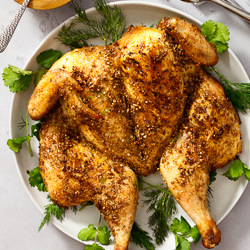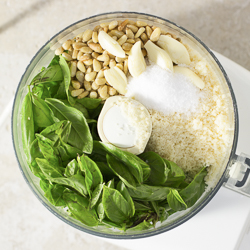Often times in a cooking class, when we’re talking about a particular dish, someone will ask “Can I double the recipe?” This Chicken Stew with Potatoes, Carrots, and Peas, for example.
So maybe you’ve wondered the same thing.
The short answer is—of course! How do you think they make big batches in restaurants or for mass production? They start with small batches to perfect them into recipes they like and then they scale them up.
But the longer answer is absolutely, you can double, triple, and even quadruple a recipe or more. You just have to do it wisely.
Here are a few things to take into account.
1. Increasing the volume of a recipe will increase its cooking time.
It makes sense, right? On the stovetop, it’ll take longer for, say, 8 cups of liquid to come to a boil than 4 cups.
And in the oven, it’ll take longer to cook, say, 2 sheet pans of cookies than 1. There’s simply more not-yet-oven-temperature stuff in there, initially reducing the oven’s temperature more drastically. Plus more volume of stuff for that heat, once it recovers, to permeate.
But how much will those increases effect cooking time? Unfortunately, it’s not a direct correlation. In other words, twice the amount of food doesn’t take twice as long to cook.
Which is one of the many reasons why any decent recipe should have a visual or texture cue for doneness—as in “simmer until the potatoes are tender, 7 to 10 minutes” or “bake until the cookies are browned and set, 18 to 20 minutes.” You’re done when you have tender potatoes or browned, set cookies. The cooking times are merely guidelines.
The cues are what you should looking at to know if your food is done, not the clock—for a doubled recipe, yes, but really for any recipe.
2. If you’re looking to brown or sear something, you need to increase the cooking surface or cook in batches.
All food has a high proportion of water. And when you cook, that water burns off in the form of steam. That’s why some recipes tell you not to crowd the skillet—because the recipe is going for browning, which adds yummy, roasty toasty flavors, and all the steam being released in a crowded skillet is antithetical to that.
So if you’re doubling a recipe that includes, say, chicken thighs seared in a skillet or stew meat pieces browned in a stockpot, you need to a) double the cooking surface’s area, b) cook the chicken or stew meat in 2 batches, or c) crowd the skillet or stockpot and sacrifice browning.
Option C is the easiest, but little things like browning can be the difference between food that’s good and food that’s great.
3. Spicy ingredients shouldn’t be scaled up directly.
With a few caveats, to double a recipe, double the ingredients. Spicy ingredients—like cayenne, hot sauce, and even black pepper—are one of those caveats. Their heat can build exponentially as opposed to proportionally. So start with about 1 1/2 times the spicy ingredient in a doubled recipe, then taste and adjust.
4. Baking is its own animal.
When you’re baking, you also need to consider the cooking surface—or more precise to baking, the baking pan. If you put twice the amount of cake batter into a pan that doesn’t have twice the area, your cake will be thicker in the pan, which will not only affect its cooking time but also likely require a different temperature so the cake won’t be overcooked on the outside before it’s cooked through on the inside. So either cook in two pans or adjust time and temperature accordingly.
And then there’s just the chemistry of baking, where cooking is about time and temperature but also the chemical reactions that happen between the ingredients in the recipe. Like spicy ingredients, leaveners—like baking soda and baking powder—don’t scale up proportionately. Some sources say to reduce the amount of each by 1/8 teaspoon when doubling a recipe.
But I say go ahead and scale up a recipe as you see fit—just know that it might take a few tries before a larger batch turns out like the smaller one.
Bottom line, it’s usually not twice the work to make twice the batch. So if you make extra, say, Chicken Stew now and freeze the leftovers, it’ll be way easier to enjoy again later than it would be to make a second batch. That’s why bigger batches are one of my favorite strategies for easily enjoying great meals more often.
So whether it’s because you need more now or you want to save some for later, go ahead and double the recipe. Just do it wisely.
Some of my favorite recipes to double:
Chocolate Muffins
Banana Walnut Muffins
Raspberry Vanilla Bean Scones
Rustic Gruyère Chive Scones
Cherry Almond Granola
Chicken Stew with Potatoes, Carrots, and Peas
Wine-Simmered Beef Stew with Carrots, Mushrooms, and Sweet Onions
Sierra Chicken Stew
Chunky Beef and Syrah Chili
Chicken Pozole Verde
Colorful Vegetable and Lentil Soup
Simple, Satisfying Minestrone Soup
Speedy Tomato Sauce
Flavored butters—Sundried Tomato, Blue Cheese, and Rosemary and Lemon-Thyme
Marinated Olives with Citrus and Garlic
Salted Cherry Almond Oatmeal Cookies
The World’s Best Chocolate Chip Cookies











